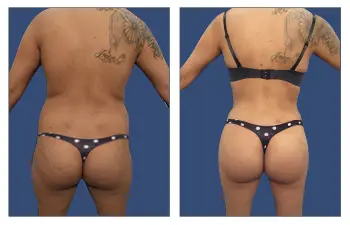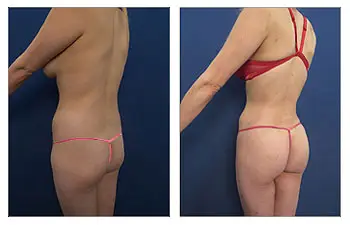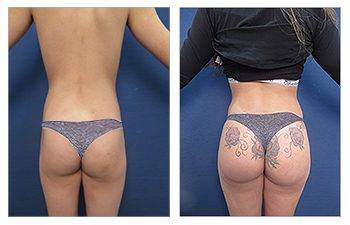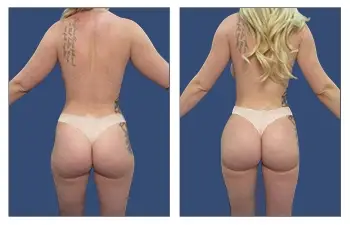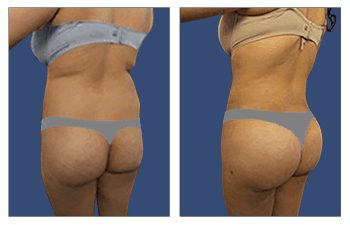Introduction to Why is BBL So Dangerous?
The Brazilian Butt Lift (BBL) has gained immense popularity over the years for satisfying the desire for a fuller and shapelier derriere. However, it is crucial to acknowledge that the BBL procedure comes with its fair share of dangers and risks. One cannot overlook the high mortality rate associated with this cosmetic surgery, making it imperative to delve deeper into the reasons behind its dangers.
One of the primary dangers of the Brazilian Butt Lift is the risk of fat embolism. This occurs when some of the injected fat enters the bloodstream, obstructing blood vessels and leading to severe complications. Fat embolism is a life-threatening condition that can result in major organ damage or even death. The risk of fat embolism is particularly high during a BBL due to the large volumes of fat that are injected into the buttocks.
Moreover, surgical complications are another significant concern when it comes to the dangers of BBL. The procedure involves liposuction to remove excess fat from one area of the body, which is then carefully injected into the buttocks. However, complications such as bleeding, infection, and excessive contour irregularities may arise during the process. These surgical complications can have detrimental effects on a patient’s overall health and well-being.
Furthermore, the alarming mortality rate associated with the BBL procedure can often be attributed to unqualified practitioners performing the surgery. Inadequate training and lack of expertise can greatly contribute to the dangers faced by individuals seeking a Brazilian Butt Lift. It is crucial for patients to thoroughly research and choose a board-certified plastic surgeon with specific expertise in performing BBLs to minimize the risks involved.
What Are The Risks Of Fat Grafting?
Fat grafting, also known as fat transfer or fat injections, is a popular cosmetic procedure that involves removing fat from one part of the body and injecting it into another area to plump up or enhance specific features. While the procedure has gained popularity due to its effectiveness and natural-looking results, it is essential to be aware of the potential risks and complications associated with fat grafting. Understanding these risks can help individuals make informed decisions and ensure a safe and successful outcome. From infection and asymmetry to over correction and poor fat survival, this article will explore some of the risks that individuals should consider before undergoing fat grafting.
Fat grafting necrosis
Fat grafting necrosis is a potential risk and complication associated with fat grafting procedures. This condition occurs when transplanted fat cells fail to survive due to insufficient blood supply, leading to tissue death. Several factors contribute to the occurrence of fat grafting necrosis, including improper injection techniques and the use of excessive amounts of injected fat.
Improper injection techniques can impede blood flow and compromise the survival of transplanted fat cells. If the fat is injected too deeply or too superficially, it may not receive adequate oxygen and nutrients, resulting in necrosis. Additionally, injecting fat too rapidly or with too much pressure can damage blood vessels, further impairing blood flow to the graft.
Using excessive amounts of injected fat can also increase the risk of fat grafting necrosis. When an excessive volume of fat is transplanted, the blood vessels in the target area may be overwhelmed, leading to compromised blood flow and subsequent necrosis. Furthermore, large volumes of injected fat can create increased pressure within the tissues, further compromising blood supply.
The consequences of fat grafting necrosis can be significant. Tissue damage can occur, leading to pain, swelling, and changes in the texture and appearance of the affected area. If the necrotic tissue becomes infected, there is an increased risk of abscess formation and systemic infection. Moreover, impaired healing may occur, prolonging the recovery process and potentially requiring additional procedures for correction.
Fat Graft Blow Out
Fat Graft Blow Out is a term used to describe the potential risks and complications associated with fat grafting procedures. This phenomenon occurs when an excessive amount of fat is injected or when it is injected too deeply into the recipient area, leading to life-threatening complications like fat embolization.
One of the main risks of fat graft blow out is excessive injection, where an overwhelming amount of fat is injected into the targeted area. This can lead to several complications, including fat embolization. Fat embolization occurs when the injected fat enters the bloodstream and travels to vital organs such as the lungs, brain, or heart, potentially causing severe damage or even death.
The injection of fat too deeply is another factor that can contribute to fat graft blow out. When fat is injected too deeply, it can result in damage to blood vessels and nerves, leading to irregularities, infections, or even necrosis in the surrounding tissues. These complications can have long-lasting effects and may require extensive medical intervention.
The possible outcomes and effects of fat graft blow out can range from mild to severe. Mild complications may include bruising, swelling, or localized pain in the injected area. However, in severe cases, fat embolization can lead to stroke, organ failure, or even cardiac arrest.
In conclusion, fat graft blow out is a serious risk associated with fat grafting procedures. Excessive injection or injecting fat too deeply can lead to life-threatening complications like fat embolization. It is crucial for healthcare professionals to carefully assess and administer the appropriate amount of fat to minimize the risks and ensure patient safety.
BBL Related Fat Emboli
BBL, or Brazilian Butt Lift, is a popular cosmetic procedure designed to enhance the shape and size of the buttocks. However, it is important to be aware of the potential risks associated with this procedure, including the risk of fat emboli.
Fat emboli occur when small droplets of fat enter the bloodstream and travel to other parts of the body, potentially blocking blood vessels. In the case of a BBL, fat emboli can occur when fat cells are accidentally injected into a blood vessel during the fat grafting process. This can lead to serious complications, including respiratory distress, damage to the lungs, or even death.
Symptoms of fat emboli can vary depending on the affected area, but common signs include shortness of breath, chest pain, rapid heart rate, and confusion. In severe cases, patients may experience respiratory failure or cardiac arrest.
To address and prevent fat emboli following a BBL procedure, thorough patient evaluation is essential. This includes a detailed medical history, physical examination, and assessment of any risk factors, such as previous clotting disorders or medical conditions that may increase the risk of emboli.
Proper surgical techniques are also crucial in preventing fat emboli. Surgeons should use small, blunt cannulas during the fat transfer process to minimize the risk of injecting fat into blood vessels. Additionally, surgeons must constantly monitor the pressure and volume of fat being injected to ensure safe and appropriate placement.
Postoperative monitoring is vital in identifying early signs of fat emboli and allowing for timely intervention. Close observation of the patient’s vital signs, heart rate, and oxygen levels should be carried out to detect any potential complications. Early recognition is essential for prompt treatment, which may include interventions such as oxygen therapy or surgical intervention to remove the emboli.
How Can You Get A Safe Brazilian Butt Lift?
The popularity of the Brazilian Butt Lift (BBL) procedure has surged in recent years, with many individuals desiring a more curvaceous and lifted backside. However, it is crucial to prioritize safety when undergoing this surgical enhancement. A safe Brazilian Butt Lift not only ensures desirable results but also minimizes the risks and complications associated with the procedure. In this article, we will explore the key steps to get a safe and successful BBL, including finding a skilled and experienced surgeon, understanding the procedure, and adhering to pre and post-operative instructions. By following these guidelines, individuals can achieve the desired aesthetic outcome while maintaining their overall well-being.
Know your buttock anatomy
When considering buttock enhancement through cosmetic surgery, it is crucial to have a thorough understanding of buttock anatomy. This knowledge is vital in order to make an informed decision regarding the choice of a cosmetic surgeon, as only a professional with expertise in buttock enhancement should be trusted with such procedures.
Understanding buttock anatomy allows individuals to have realistic expectations about the outcomes of the cosmetic surgery. By knowing the various layers of fat, muscle, and tissue that make up the buttocks, patients can better comprehend the potential results and limitations of the procedure. This awareness helps in setting realistic goals and ensures satisfaction with the final outcome.
Additionally, being aware of buttock anatomy enables patients to identify potential risks and complications associated with buttock enhancement surgery. Knowledge about the location of nerves, blood vessels, and major muscles in the buttock area can help in determining the complexity of the procedure and the level of skill required from a surgeon.
Key factors of buttock anatomy that one should be aware of include the location and distribution of fat deposits, the shape and proportions of the buttocks, and the strength and elasticity of the surrounding muscles. Understanding these factors allows individuals to communicate their desired aesthetic goals effectively to the cosmetic surgeon and ensures that the surgeon can tailor the procedure to meet those goals.
Experienced BBL Surgeon
When undergoing a Brazilian Butt Lift (BBL) procedure, it is crucial to choose an experienced surgeon to minimize the risks associated with this popular cosmetic surgery. The data from South Florida has revealed a significant percentage of BBL-related deaths, highlighting the importance of selecting a surgeon with the necessary expertise and experience.
The South Florida data specifically indicates that a considerable number of these tragic deaths were caused by board-certified plastic surgeons. This surprising revelation serves as a stark reminder that certification alone does not guarantee a successful outcome. While all surgeons must complete the necessary training and education to become board-certified, it is the practical experience and skill set acquired over time that truly matters in complex procedures like a BBL.
An experienced BBL surgeon possesses in-depth knowledge of the anatomy and technical nuances associated with fat transfers and buttock augmentation. They have developed their techniques through years of practice, learning from previous cases and adapting their approaches to deliver optimal results. This hands-on experience enables them to navigate potential complications and provide the highest level of patient care.
By selecting an experienced BBL surgeon, you significantly reduce the risk of complications and potential fatalities. Their proficiency in performing the procedure ensures that each step is executed with precision, minimizing the chances of adverse events. Furthermore, they possess the expertise to identify potential risk factors in a patient and customize the procedure accordingly.
Use of large bore grafting cannulas
Large bore grafting cannulas are specialized instruments used in vascular grafting procedures. They serve the purpose of allowing the surgeon to connect the graft to the recipient blood vessels effectively and efficiently. These cannulas have several key features that make them ideal for this purpose.
Firstly, large bore grafting cannulas have a wide and smooth inner lumen, allowing for the passage of large volumes of blood and reducing the risk of clot formation. This ensures proper blood flow throughout the graft and minimizes the possibility of ischemic damage or clot formation. Additionally, they are often made from biocompatible materials such as medical-grade stainless steel or silicone, reducing the risk of adverse reactions or rejection.
Large bore grafting cannulas are suitable for use with various types of vessels. They can be used in larger blood vessels, such as the aorta or major veins, where the diameter requires a larger cannula for effective grafting. This includes procedures like aortic aneurysm repair, bypass surgeries, and organ transplantation.
The use of large bore grafting cannulas offers several benefits. They enable faster and more efficient graft connection, reducing surgical time and potentially minimizing the risk of complications. Additionally, their wide caliber allows for improved blood flow, promoting better tissue perfusion and reducing the likelihood of graft failure.
However, there are potential risks associated with using large bore grafting cannulas. They can cause injury to the vessel walls if not handled with care, leading to bleeding or damage to surrounding tissues. Furthermore, the larger size of the cannulas may require larger incisions, resulting in increased scarring or risk of infection.
Ultrasound Guided Fat Grafting
Ultrasound guided fat grafting is a innovative technique used to enhance volume and contour irregularities in various areas of the body, such as the face, breasts, and buttocks. This procedure involves injecting fat cells into the subcutaneous layer using ultrasound imaging guidance.
Ultrasound is used to guide the injection of fat cells into the subcutaneous layer. The ultrasound imaging provides real-time visualization, allowing the physician to accurately assess the depth and location of the injection, reducing the risk of complications and ensuring optimal results. Additionally, ultrasound imaging helps identify areas with inadequate fat volume, ensuring precise placement of the fat cells.
The steps involved in performing ultrasound guided fat grafting start with the preparation of the patient. This includes a thorough examination of the areas to be treated and discussion of the patient’s desired outcome. Next, the patient undergoes a sterile preparation and local anesthesia is administered to minimize discomfort.
Once the patient is prepared, ultrasound imaging is used to identify the subcutaneous layer and locate areas with insufficient fat volume. The fat cells are then harvested from another area of the patient’s body using liposuction techniques. The harvested fat cells are purified and prepared for injection.
Using the real-time ultrasound imaging, the physician guides the injection needle to the desired location in the subcutaneous layer. The fat cells are injected gradually, layer by layer, to achieve an even distribution and optimal contouring. After the injections, the treated area is carefully monitored to ensure proper placement and assess the need for additional grafting.
In conclusion, ultrasound guided fat grafting is a technique that utilizes ultrasound imaging to guide the injection of fat cells into the subcutaneous layer. This procedure requires careful patient preparation, utilization of ultrasound imaging for real-time visualization, and precise injection techniques to achieve optimal results.
Limiting Fat grafting to above the buttock muscle
Limiting fat grafting to above the buttock muscle is crucial to ensure a safe procedure and minimize the risks and complications associated with gluteal fat grafting. Injecting fat below the muscle during this procedure can lead to various potential risks and complications.
One significant danger is fat embolization, which occurs when fat enters the bloodstream and travels to vital organs like the heart and lungs. Injecting fat too deeply into the gluteal muscles increases the risk of fat embolization, as the fat can enter the blood vessels surrounding these areas and potentially block blood flow. Fat embolization in the heart can result in heart attacks, while in the lungs, it can cause pulmonary embolism, a life-threatening condition.
Limiting fat grafting to above the buttock muscle helps reduce the risk of fat embolization, as the fat is less likely to enter the blood vessels in this area. By staying above the muscle, the surgeon ensures that the injectable fat is placed in a safe location away from vital structures, minimizing the chances of complications.
In addition to fat embolization, injecting fat below the muscle can lead to other complications. These may include infection, hematoma formation, asymmetry, contour irregularities, and loss of fat graft viability.
Conclusion: Why is BBL so Dangerous?
In summary, the Brazilian Butt Lift (BBL) procedure poses significant dangers, with one of the most serious being the risk of fat embolism. Fat embolism occurs when fat particles enter the bloodstream and travel to vital organs, potentially causing life-threatening complications. This danger is primarily attributed to the improper injection technique used during the procedure, where fat is injected too deeply or in large quantities. In addition, the procedure can damage blood vessels, leading to fat leaking into the bloodstream.
To address these dangers, plastic surgery societies have made efforts to create guidelines for safer BBL procedures. These guidelines emphasize the importance of performing fat injections superficially and in small volumes while avoiding deep injection into the muscles. Surgeons are also encouraged to assess the patient’s overall health and blood supply to ensure a safer surgical experience.
Despite these efforts, it is crucial for individuals considering a BBL to understand the potential risks involved. It is recommended to consult with a board-certified plastic surgeon who can provide a thorough evaluation and ensure the procedure is performed safely. By raising awareness about the dangers of BBL and adopting proper guidelines, we can aim to minimize the risks associated with this popular cosmetic procedure.

